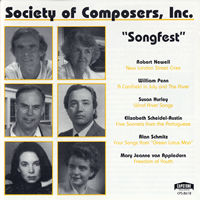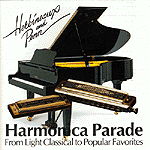Garland in Song |
||||
|
Hamlin Garland had a deep and lasting appreciation for music that was an integral part of his life. His parents loved to sing, and all seven of his aunts and uncles (of his mother's family, the McClintocks) were accomplished musicians. His daughters remember Garland with a song on his lips (his favorites were Scots and Irish ballads), and at one time the homestead in West Salem boasted three pianos. Garland registered his interest in song by referring to song and music and its influence upon him in each of the four volumes of his autobiography, the "Middle Border" books, and he entitled his first collection of poems Prairie Songs (1893). As Whitman used the image of grass as the organizing principle of Leaves of Grass, Garland describes in his poems the sound and music of the prairie of his youth, filtered through a nostalgic recollection. He would doubtless be gratified to learn that composers continue to find his poetry inspiration for song. |
||||
|
|
||||
Adaptations |
||||
| Do You Fear the Wind?
Do you fear the force of the wind, |
Do You Fear the Wind? | |||
| Arranged by Leland Sateren and performed by the Naperville Men's Glee Club at the New York Choral Festival in Lincoln Center's Alice Tully Hall in 2000. | ||||
| .mp3 file (844 KB) | Real audio (403 KB) | |||
| Need the Real Player? | ||||
| "Do You Fear the Wind?" was first published in McClure's magazine in April 1899 and reprinted in The Trail of the Gold-Seekers (1899). | ||||
|
|
||||
 |
A Cornfield in July and The River |
|||
|
For medium voice and wind ensemble (twenty-five performers).
Robert Maher, baritone.
Steven Eldridge, piano.
Music by William Penn; based on the poetry and writings of Hamlin Garland. Cleveland, Ohio: Ludwig Music, 1995. 1 score (71 p.) ; 36 cm. + 2 vocal scores (27 p. each) + 25 parts ; 28 cm. |
||||
|
Notes: Originally for voice and piano. Words printed as text on p. 3. Duration: 8:45. |
bio of William Penn |
|||
| Excerpt: .mp3 file (1.8 MB) |
Real audio (484 KB) |
|||
| http://www.capstonerecords.org/CPS-8618.html | ||||
|
|
||||
 |
A Cornfield in July and The River | |||
| Adapted for the harmonica by Pierre Herbineaux | ||||
| "Harmonica Parade." Harmonica (Pierre Herbineaux) and Piano (William Penn) from Blues to Bach. Belgian and USA. |
||||
| http://www.aurec.com/releases/harmonica.html | ||||
|
|
||||
| Garland Songs : for medium voice and pianoforte. | ||||
| Based on the poetry and writings of Hamlin Garland ; music by William Penn. Cleveland, Ohio : Ludwig Music, 1994. 1 score (viii, 67 p.) ; 30 cm. Contents: Moggin' along (7:00) -- Then it's spring : part I (0:15) -- Spring rains and Out of the Mayweed (3:15) -- Then it's spring : part II (0:40) -- A cornfield in July and The river (8:00). Total duration: about 20:30. |
||||
|
|
||||
| Do You Fear the Wind? | ||||
| Arranged by Elinor Remick Warren. New York: Carl Fischer, 1937. Location: New York Public Library, Free Library of Philadelphia Dedication: "To Mr. Howard Swan and the Occidental College Men's Glee Club" |
||||
| http://www.elinorremickwarren.com/catalog_mchorus_acapell.htm | ||||
|
|
||||
| Do You Fear the Wind? | ||||
| For mixed voices. Music by Beatrice Laufer; poems by Hamlin Garland. New York: Associated Music Publishers, 1948. 1 score (5 p.) For chorus (SATB) and piano. Duration: 3:00. Location: American Music Center, New York Public Library |
||||
|
|
||||
| The Mountains | ||||
| Music by Elliot Griffis; words by Hamlin Garland; revised by the composers. Hollywood, Calif.: Carlvi Music, 1956. 1 score ([3] p.) ; 31 cm. For medium voice and piano. Location: American Music Center, New York Public Library |
||||
|
|
||||
| The Grocer | ||||
|
Song 2 of Songs of Madness and Sorrow. Music: by Daron Hagen. Premiered by Paul Sperry, tenor in a 20th Century Classical style Text: by Hamlin Garland from the author's "A Day's Pleasure," Main Traveled Roads. |
||||
| http://www8.addr.com/~pazzobas/cat/SoCo64.html#379 | ||||
| To learn more about Garland's interest in song, see Ray B. Browne, " 'Popular' and Folk Songs: Unifying Force in Garland's Autobiographical Works." Southern Folklore Quarterly 25.3 (1961): 153-66. Rpt. in Critical Essays on Hamlin Garland. Ed. James Nagel. Boston: G. K. Hall, 1982. 258-69. | ||||
|
|
||
| Maintained by Keith Newlin | ||
Last Updated:
09/12/2015


